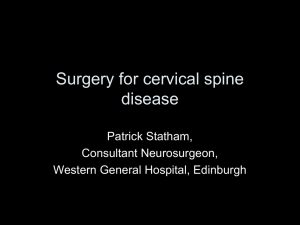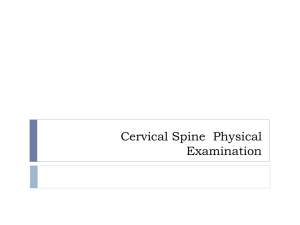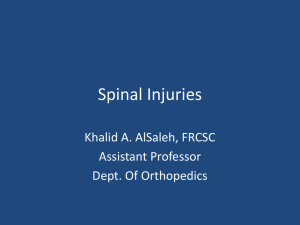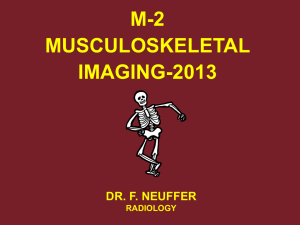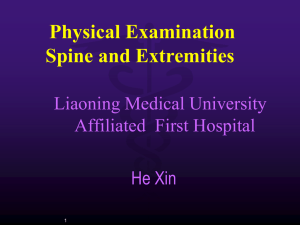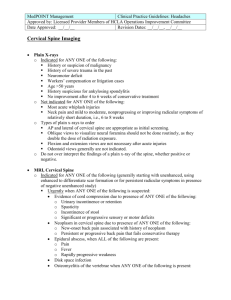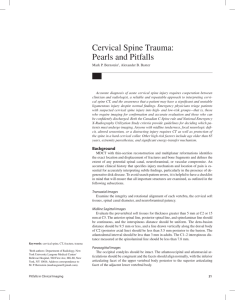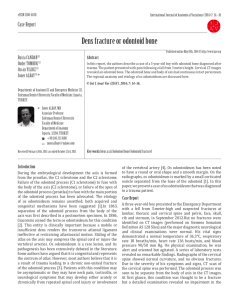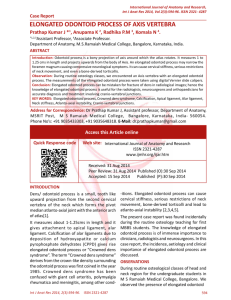Head & Neck Trauma
advertisement
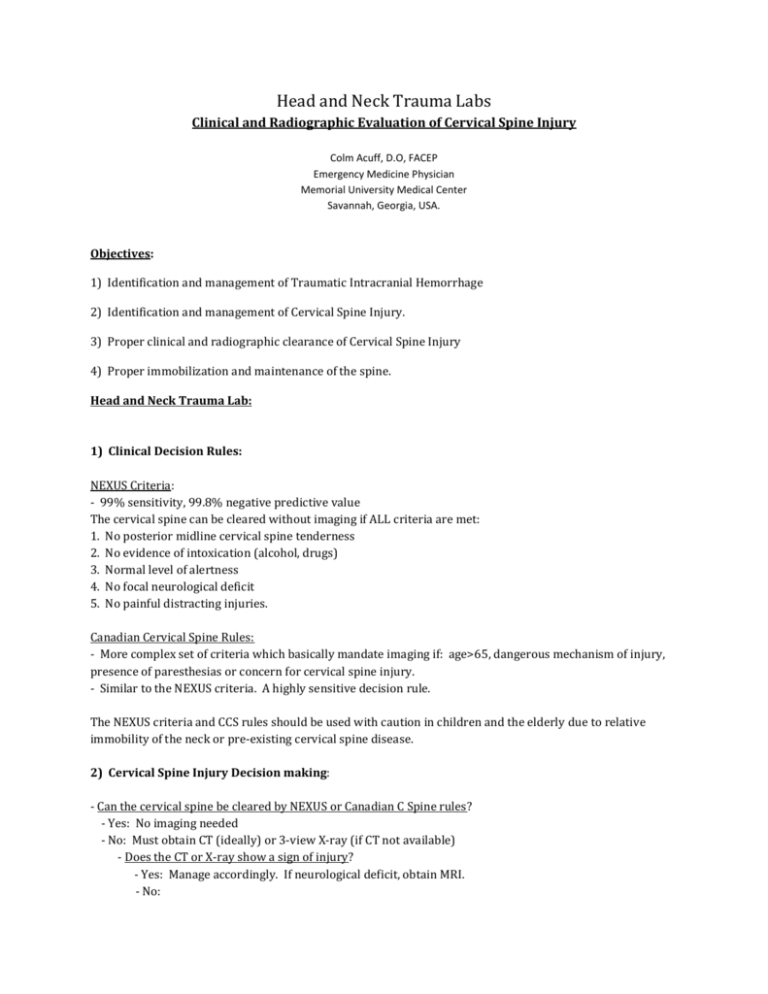
Head and Neck Trauma Labs Clinical and Radiographic Evaluation of Cervical Spine Injury Colm Acuff, D.O, FACEP Emergency Medicine Physician Memorial University Medical Center Savannah, Georgia, USA. Objectives: 1) Identification and management of Traumatic Intracranial Hemorrhage 2) Identification and management of Cervical Spine Injury. 3) Proper clinical and radiographic clearance of Cervical Spine Injury 4) Proper immobilization and maintenance of the spine. Head and Neck Trauma Lab: 1) Clinical Decision Rules: NEXUS Criteria: - 99% sensitivity, 99.8% negative predictive value The cervical spine can be cleared without imaging if ALL criteria are met: 1. No posterior midline cervical spine tenderness 2. No evidence of intoxication (alcohol, drugs) 3. Normal level of alertness 4. No focal neurological deficit 5. No painful distracting injuries. Canadian Cervical Spine Rules: - More complex set of criteria which basically mandate imaging if: age>65, dangerous mechanism of injury, presence of paresthesias or concern for cervical spine injury. - Similar to the NEXUS criteria. A highly sensitive decision rule. The NEXUS criteria and CCS rules should be used with caution in children and the elderly due to relative immobility of the neck or pre-existing cervical spine disease. 2) Cervical Spine Injury Decision making: - Can the cervical spine be cleared by NEXUS or Canadian C Spine rules? - Yes: No imaging needed - No: Must obtain CT (ideally) or 3-view X-ray (if CT not available) - Does the CT or X-ray show a sign of injury? - Yes: Manage accordingly. If neurological deficit, obtain MRI. - No: - Is there neurologic deficit? - Yes: Obtain MRI if available - No: - Is there persistent cervical spine tenderness? - No: Cervical spine cleared - Yes: - Can the patient actively flex and extend neck? - No: semi-rigid cervical collar, follow up in 7 days - Yes: Obtain flexion-extension x-rays - If normal: outpatient follow-up - If abnormal: MRI or Neurosurgical management. Collar. 3) Imaging of the Cervical Spine: - X-Ray: Increased sensitivity with 3 views over lateral view only - CT: Better than X-Ray for fractures and dislocations. Poor for ligamentous injury - MRI: Good for soft tissue and ligamentous injury. Not as good as CT for bone. Focus will be on plain radiographs for resource-restricted emergency centers 4) X-Ray Technique: - Standard 3 views: anterior-posterior, lateral, open-mouth odontoid (dens) view - Lateral view must include base of occiput to top of T1 - Swimmer’s view may be needed to view top of T1 5) X-Ray Review: Anterior-Posterior View: - Spinous processes should line up - Disc spaces and vertebral body heights should be uniform Lateral View - Alignment: anterior vertebral line, posterior vertebral line, spinolaminar line, posterior spinous line. - Bony integrity: look for incongruities - Cartilage: - Predental space: normal is <3mm in adults and <5mm in children - Abnormal width: odontoid fracture or transverse ligament injury - Interspinous space of C1-C2: normal is <10mm - Spaces between discs and spinous processes should be uniform - Disc Spaces: - Vertebral bodies should all appear as cuboid boxes (except C1,C2) - Anterior wedging or teardrop fracture of antero-inf portion: compression fx - Anterior compression >40% of body height = burst fracture - Soft tissue: normal measurements - Nasopharyngeal space (C1): <10mm (adults) - Retropharyngeal space (C2-4): <7mm - Retrotracheal space (C5-7): <14mm (children), <22mm (adults) or <1 vertebral body width. Open Mouth (Odontoid) View: - Spaces should be equal bilaterally and <5mm between anterior arch of C1 and the odontoid Flexion-Extension Views: - Indicated for ongoing pain of the cervical spine in a fully alert and neurologically intact patient with a normal 3-view x-ray series. Looks for ligamentous instability. - Patient must be able to fully flex and extend their neck voluntarily and actively Pseudosubluxation: A normal pediatric variant - May be seen in patients <18years but most common in those <8 years. - Usually between C2-C3, and less commonly at C3-4, C4-5 - Preservation of the spinolaminar line in flexion/extension views 6) Injuries: The cervical spinal column is the most frequently injured segment (60%) due to its flexibility and exposure. Alanto-occipital dislocation: - Disruption between the base of the skull and C1. - Basion-axial interval is >12mm - Usually fatal Jefferson’s Fracture: C1 “blow-out” fracture of the ring. - Most common C1 fracture, vertical compression or hyperextension mechanism - 15-20% may be associated with a C2 fracture, and 25% with a lower cervical injury - Displacement of C1 lateral masses on odontoid view - Increased predental space on lateral view if disruption of transverse ligament - Unstable Hangman’s Fracture: C2 bilateral pedicle fracture - Hyperextension-distraction injury mechanism - C2 vertebral body anteriorly displaced if disruption of anterior longitudinal ligament. Pre-vertebral soft tissue swelling on lateral view. - Unstable C2 Odontoid (Dens) Fractures: - Variable mechanism of injury - >5mm between anterior arch of C1 and the odontoid on open-mouth view - Type I: 7% of odontoid fractures. Avulsion of the odontoid tip. Generally stable - Type II: 60% of odontoid fractures. Fracture through the base. Generally unstable. The epiphysis in young children may be confused with this fracture. - Type III: 30% of odontoid fractures. Fracture through the base and body of C2. Unstable. Burst Fracture: C3-C7 Compression fractures with retropulsion of bony fragments - Vertical Compression mechanism - Spinal cord injury possible if significant bone retropulsion - Stability dependent on ligamentous integrity Flexion or Extension Teardrop Fracture: - Hyperflexion or hyperextension mechanism - Fracture of the anteroinferior portion of the vertebral body - Unstable – torn posterior ligaments Clay Shoveler’s Fracture: C7>C6>T1 - Hyperflexion mechanism (sudden load on a flexed spine) - Fracture of the spinous process - Stable Transverse Process Fracture: - Lateral flexion mechanism - May be associated with vascular injury Unilateral Facet Dislocation: - Flexion-rotation mechanism - anterior vertebral body displacement <50% - Stable (except at C1,C2) Bilateral Facet Dislocation: - Hyperflexion injury - anterior vertebral body displacement >50% - Very Unstable with high incidence of spinal cord injury Stable vs. Unstable Injuries: - Stability of the cervical spine provided by the anterior column and posterior column. - Disruption of both columns makes the injury unstable.

